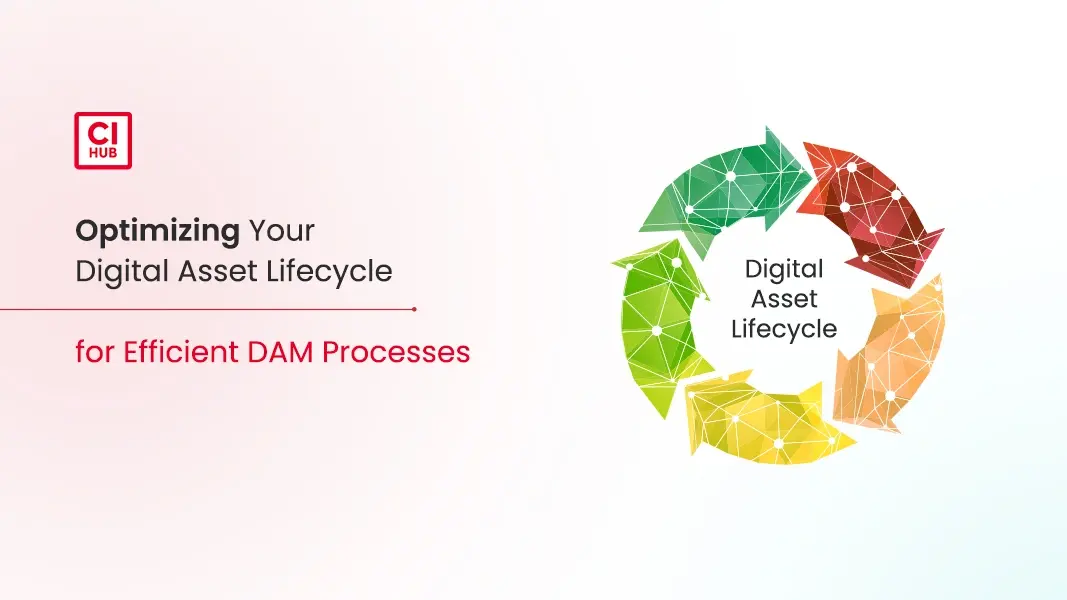
October 07, 2025
Optimizing Your Digital Asset Lifecycle for Efficient DAM Processes
TL;DR
An optimized digital asset lifecycle allows teams to manage content efficiently from creation to archiving. When supported by DAM solutions and connectors, workflows become faster, collaboration is more streamlined, and assets are easier to locate, share, and repurpose. This keeps projects on schedule and ensures they stay aligned with brand standards.
In this blog, we will cover:
Introduction
What is the Digital Asset Lifecycle?
What Are the Stages of Digital Asset Lifecycle?
Common Challenges in Managing the Digital Asset Lifecycle
How to Optimize the Digital Asset Lifecycle
Why Is A Well-Managed Digital Asset Lifecycle So Important for Brand Consistency?
The Bottom Line
Frequently Asked Questions
Introduction
Digital content exists in countless forms, from videos, images, presentations, and documents. For marketing and creative teams, having everything sorted out and accessible can be a significant challenge.
Every asset goes through a cycle, from creation through delivery and ultimately to archiving. Being aware of each stage in this process, teams can work in collaboration, and the content will be utilized appropriately.
In this blog, we will explore the stages of the digital asset lifecycle and share practical strategies to streamline workflows while keeping brand standards consistent.
What is the Digital Asset Lifecycle?
The digital asset lifecycle is the journey that every digital content takes from creation to archiving. Understanding this lifecycle allows marketing and creative teams to keep assets organized, easy to locate, and consistently aligned with brand standards.
Key Stages of the Digital Asset Lifecycle:
- Creation
- Organization
- Storage
- Retrieval
- Distribution
- Archiving
By following a clear lifecycle, teams can reduce errors, improve collaboration, and make sure every asset is used effectively. A well-managed lifecycle supported by a Digital Asset Management (DAM) system ensures that content remains reliable, accessible, and consistently on-brand throughout its life.
What Are the Stages of Digital Asset Lifecycle?
Understanding each stage of the digital asset lifecycle is key to managing digital media assets efficiently. Here are the key stages of a digital asset:
Creation
This is the starting point of the digital asset lifecycle. During creation, teams generate new content such as images, videos, presentations, or documents. Key tasks in content creation include:
- Ideation and conceptualization of the asset
- Draft creation and internal reviews
- Adding initial metadata to make future retrieval easier
Proper setup at this stage ensures the digital asset management process begins on a strong foundation and sets the stage for efficient workflows.
Organization
Once created, assets need to be structured within your DAM system. Organizing content effectively makes retrieval faster and reduces duplication. Important actions of content organization include:
- Categorizing assets into folders or collections
- Tagging with descriptive keywords
- Establishing consistent naming conventions
- Linking related assets to group campaigns or projects
- Applying version control to track updates and revisions
Storage
Proper storage is essential for maintaining asset integrity and accessibility. Using DAM tools, teams can store assets securely while ensuring they are easy to locate later. Key practices for efficient asset storage are:
- Centralizing storage in a single repository or system of record
- Implementing backup and redundancy to prevent data loss
Efficient storage supports content lifecycle management and simplifies ongoing management of digital media assets.
Retrieval
Retrieval focuses on how quickly and accurately users can find the assets they need. Effective retrieval saves time and reduces errors in projects. Key practices include:
- Leveraging metadata, tags, and keywords for search
- Using filters or advanced search functions in DAM solutions
- Providing clear access permissions to prevent confusion
A streamlined retrieval process ensures teams can access the right assets at the right time, keeping creative workflows efficient.
Distribution
Once assets are ready, they need to reach the right teams, stakeholders, or channels. Proper distribution ensures content is used correctly and efficiently. Key steps of the process include:
- Sharing assets internally across departments
- Delivering content to external partners or agencies
- Publishing approved assets to digital channels or campaigns
- Using automated delivery or notification workflows to streamline sharing
Leveraging DAM connectors and integration tools allows teams to distribute assets efficiently across channels and ensure brand consistency at every touchpoint.
Archiving
The final stage of the digital asset lifecycle involves retiring the assets that are no longer needed. Proper archiving keeps the DAM system organized and preserves previous content for future use. It ensures teams have a clean, manageable repository while safeguarding valuable digital media assets.
Best practices include:
- Moving inactive assets to archive folders
- Retaining metadata and usage history for reference
- Cleaning up outdated or redundant files to prevent clutter
Common Challenges in Managing the Digital Asset Lifecycle
Even with a robust DAM system, teams often face hurdles that slow down workflows and impact brand consistency. Understanding these challenges is essential to improving efficiency and maintaining creative quality.
- Fragmented Storage and Scattered Files: Assets spread across drives and platforms are hard to locate and increase the risk of outdated files being used.
- Inconsistent Metadata and Tagging: Missing or unclear tags make search inefficient and lead to duplication or mismanagement of assets.
- Duplicate Assets and Version Conflicts: Multiple copies cause confusion, with teams often relying on outdated versions.
- Slow Approvals and Bottlenecks: Manual review processes delay projects and force rushed creative decisions.
- Loss of Oversight Across the Lifecycle: Limited visibility into current or archived assets reduces productivity and brand control.
How to Optimize the Digital Asset Lifecycle
Content lifecycle management takes more than just good organization; it requires the right solutions to ensure digital assets are easy to use and share across teams and tools. For marketing and creative teams, practical solutions focus on keeping content accessible, reducing manual steps, and ensuring every asset is ready for immediate use.
- In-App Access Across Platforms: Embed DAM access directly into the applications your team uses every day. Whether it’s Microsoft Office, Adobe Creative Cloud, or Google Workspace, team members can drag, drop, and update assets without leaving their workflow.
- Streamlined Asset Distribution: Automate content delivery to internal teams, external agencies, or digital channels. Built-in connectors and integrations make it simple to push approved assets to the right place, in the right format, instantly.

- Automated Version Control: Ensure all users are working with the latest files. Integrations and DAM connectors automatically relink assets, track changes, and sync updates across platforms, preventing outdated content from being used in campaigns.
- Flexible Format Renditions: Generate multiple formats or sizes of an asset directly from the DAM without extra software. This allows teams to quickly prepare content for print, web, or social media without manual resizing.
- Real-Time Collaboration: Use in-app review and approval workflows so multiple teams can provide feedback simultaneously. Connectors enable approvals, comments, and edits without switching between tools, keeping creative and marketing teams aligned.
These practical approaches turn a DAM from a storage system into a dynamic workspace. By leveraging integrations, connectors, and real-time capabilities, teams can accelerate the lifecycle, reduce friction, and maintain consistent, high-quality outputs across every project.
Why Is A Well-Managed Digital Asset Lifecycle So Important for Brand Consistency?
A structured digital asset lifecycle goes beyond preventing outdated content. It ensures teams can quickly access the right assets, maintain approvals, and implement brand updates across all channels. This reduces errors, accelerates campaign execution, and supports scalable workflows for distributed teams. Organizations can safeguard brand integrity, enable faster decision-making, and deliver a consistent, high-quality experience to audiences, even as content volumes grow. This proactive approach turns every asset into a reliable contributor to brand reputation and audience engagement.
The Bottom Line
Effective management of the digital asset lifecycle gives teams the agility to efficiently deliver projects. By understanding how assets move through creation, collaboration, and archiving, organizations can identify bottlenecks, optimize processes, and allocate resources more strategically. Modern DAM tools and connectors enable data-driven insights on asset usage, allowing teams to make informed decisions, plan campaigns more efficiently, and scale operations confidently. Treating assets as strategic resources transforms routine workflows into measurable business outcomes.
Frequently Asked Questions
Metadata should be added during the creation stage and refined during organization and storage. Early tagging helps with searchability, retrieval, and proper tracking of assets across the lifecycle.
Using DAM connectors or in-app integrations allows teams to automatically generate the correct formats and renditions for web, social media, print, or other channels, streamlining multi-channel distribution without manual intervention.
Archived assets should be periodically reviewed based on project cycles or compliance requirements. Regular audits help free storage, remove outdated content, and maintain a clean, organized DAM while preserving valuable historical assets for reference.

Article by
Michael Wilkinson
Marketing & Communications Consultant of CI HUB